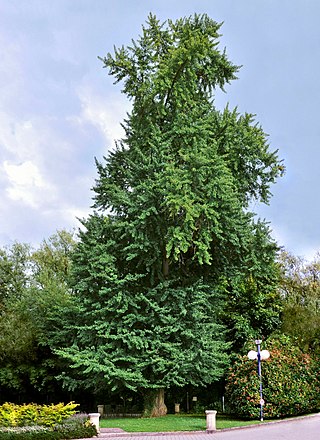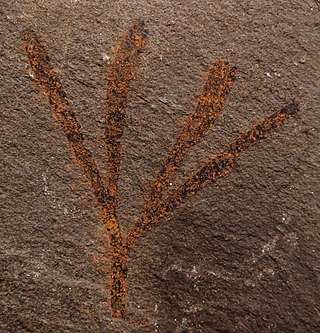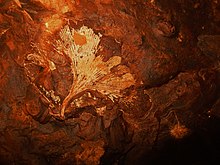
Ginkgo biloba, commonly known as ginkgo or gingko, also known as the maidenhair tree, is a species of gymnosperm tree native to East Asia. It is the last living species in the order Ginkgoales, which first appeared over 290 million years ago, and fossils very similar to the living species, belonging to the genus Ginkgo, extend back to the Middle Jurassic epoch approximately 170 million years ago. The tree was cultivated early in human history and remains commonly planted, and is widely regarded as a living fossil.

Ginkgoales are a gymnosperm order containing only one extant species: Ginkgo biloba, the ginkgo tree. The order has a long fossil record extending back to the Early Permian around 300 million years ago from fossils found worldwide.

Weald Clay or the Weald Clay Formation is a Lower Cretaceous sedimentary rock unit underlying areas of South East England, between the North and South Downs, in an area called the Weald Basin. It is the uppermost unit of the Wealden Group of rocks within the Weald Basin, and the upper portion of the unit is equivalent in age to the exposed portion of the Wessex Formation on the Isle of Wight. It predominantly consists of thinly bedded mudstone. The un-weathered form is blue/grey, and the yellow/orange is the weathered form, it is used in brickmaking.

Ginkgo is a genus of non-flowering seed plants, assigned to the gymnosperms. The scientific name is also used as the English common name. The order to which the genus belongs, Ginkgoales, first appeared in the Permian, 270 million years ago, and Ginkgo is now the only living genus within the order. The rate of evolution within the genus has been slow, and almost all its species had become extinct by the end of the Pliocene. The sole surviving species, Ginkgo biloba, is found in the wild only in China, but is cultivated around the world. The relationships between ginkgos and other groups of plants are not fully resolved.

Endennasaurus is an extinct genus of thalattosaurian from the Upper Triassic of Italy. It was found in and named after the Endenna cave, composed of Zorzino Limestone in Lombardia.
Ashorocetus is a monotypic genus of an extinct primitive baleen whale of the family Aetiocetidae. It was named by Barnes et al. 1995, and contains one species, A. eguchii. Fossils of this whale are found from the Chattian Morawan formation, near Ashoro, of upper Oligocene Hokkaido, Japan. Ashorocetus eguchii was described based on a partial skull and is named after the type locality and Kenichiro Eguchi of the Ashoro Museum of Paleontology.
Mordex is an extinct genus of temnospondyls from Carboniferous of the Czech Republic.
Glyptopomus is an extinct genus of prehistoric sarcopterygian or lobe-finned fish.

Ginkgo dissecta is an extinct ginkgo species in the family Ginkgoaceae described from a series of isolated fossil leaves. The species is known from Early Eocene sediments exposed in the province of British Columbia, Canada, and Washington, US. It is one of two Ginkgo species found at the Washington and British Columbia sites.

Sphenobaiera is a form genus for plant leaves belonging to the order Ginkgoales found in rocks from Triassic to Cretaceous periods. The genus Sphenobaiera is used for plants with wedge-shaped leaves that can be distinguished from Ginkgo, Ginkgoites and Baiera by the lack of a petiole. It became extinct about 72.6 million years ago. The family to which this genus belongs has not been conclusively established; an affinity with the Karkeniaceae has been suggested on morphological grounds.

Ginkgo cranei is an extinct Ginkgo species in the family Ginkgoaceae described from a series of isolated fossil ovulate organs and leaves. The species is known from upper Paleocene sediments exposed in the state of North Dakota, US. It is the first Ginkgo species to be described from Paleogene period with reproductive structures.

Alienochelys is an extinct genus of marine turtle known from Maastrichian-aged Cretaceous phosphates in Morocco. With a skull measuring 41.5 centimetres (1.36 ft) long, it would have been a very large turtle. It was first described as a member of the family Dermochelyidae, meaning that it is a relative of the modern leatherback turtle, though a 2018 study identifies it as a sister taxon of Ocepechelon belonging to the family Protostegidae, indicating that it may have been closer to the extinct Archelon. Unlike other sea turtles, Alienochelys' the jaws being adapted for a powerful crushing pattern well adapted for a durophagous lifestyle, as well as its unusual cranial characteristics.

Baiera is a genus of prehistoric gymnosperms in the order Ginkgoales. It is one of the oldest fossil foliage types of Ginkgoales, and is related to the genera Ginkgo and Ginkgoites. Fossils of Baiera are found worldwide, and have been known from the Permian to the Cretaceous.
Theroteinus is an extinct genus of haramiyidan mammaliaforms from the Late Triassic of France and Britain. It contains three species: T. nikolai,T. rosieriensis and T. jenkinsi, the former two of which are known exclusively from teeth found at the sand quarry of Saint-Nicolas-de-Port, while T. jenkinsi is known from a bedded sequence belonging to the Westbury Formation in a road cutting near Holwell, Dorset. Theroteinus is the only member of the family Theroteinidae and the suborder Theroteinida.

Sphodrosaurus is an extinct genus of basal archosauriform reptiles from the Late Triassic-aged New Oxford Formation of Pennsylvania. The type species is S. pennsylvanicus, described by Edwin Colbert in 1960. The holotype consists of a partial skeleton including the back of the skull, the vertebral column, all of the ribs, all of the hindlimbs and part of the upper forelimbs; Sphodrosaurus was originally believed to have been a member of the Procolophonidae while more recently Sphodrosaurus was believed to be a basal member of the Diapsida by most authors starting with Sues et al. (1993), or a member of the Rhynchosauria. In 2022, Ezcurra & Sues redescribed the holotype in detail and placed it in a phylogenetic analysis with other Triassic diapsid reptiles, where it was found as the basalmost doswellid.











